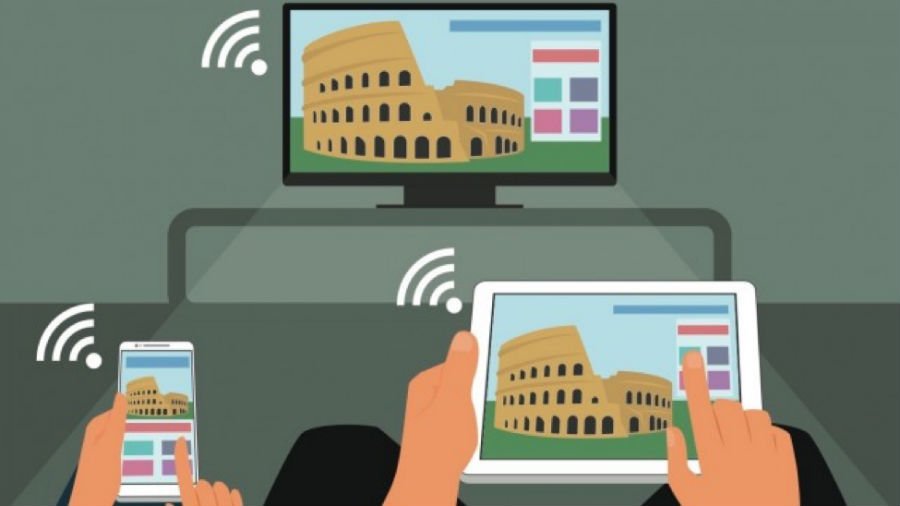Screen Mirroring 101
The Basics
What is screen mirroring?
Screen mirroring is just what it sounds like—putting what’s on the screen of one device onto another screen for easy access. Teachers use it to improve student comprehension and engagement. Salespeople, business managers, and many others use this technology every day to do their jobs more effectively.
Where is screen mirroring most effective?
In the office—Screen mirroring is taking off in office settings. The days of struggling with the right AV cable, HDMI® or VGA adapter to connect laptops to the big screen are gone. Now, presenters have gone mobile, carrying their presentations and visual aids on their mobile devices and mirroring them onto other screens. AV equipment no longer needs to be set up in advance. Wireless screen mirroring technology makes visual aids and presentations much more mobile increasing mobility and eliminating delays due to lost or mismatched cords.
In the classroom—Screen mirroring is making a big difference in education. Teachers are no longer tethered to their desks where the cable is the only option to project to their screen. These days, HDMI can go wireless. Schools have traded in their old AV equipment for sleeker, easier-to-use screen-mirroring technology. In classrooms where the students carry mobile devices, teachers can take their lessons to the next level by personalizing what each student sees on his or her individual screen.
How do I use screen mirroring?
Screen mirroring can be very simple to use, especially with Miracast-enabled devices (see below for more on Wi-Fi Miracast). To make use of screen mirroring, some basic hardware and software are needed.
For those looking for a screen-mirroring solution, ScreenBeam is an excellent option. Companies such as Microsoft, Intel, and leading PC OEM and device manufacturers use ScreenBeam as their validation platform because of ScreenBeam’s expertise in wireless screen mirroring. Here’s what you need to use ScreenBeam screen-mirroring technology in your classroom or workplace:
A computer, tablet, or smartphone—This is the screen that’s being mirrored. Newer devices work better, as Miracast-enabled devices can connect wirelessly to the display adapter. However, older devices may work just as well with the help of a USB transmitter. Here’s what you can use with ScreenBeam:
- Windows 10 laptops, tablets, and 2-in-1s with wireless display support
- Example: Surface and Surface Pro 3 & 4
- Windows 7 and Windows 8 devices (with ScreenBeam USB transmitter)
- Android mobile devices with wireless display support
- Mac OS 10 (or higher) laptops
A wireless display receiver —An HDMI receiver serves as the connection between your mobile device and the projector or display screen.
A display to “beam” to—This is essentially the “mirror” in screen mirroring, the destination screen for your image or presentation. This screen requires an available HDMI or VGA port. It can be a high-definition television, a computer monitor, a projector, or a digital whiteboard such as the ScreenBeam Touch 90.
Miracast basics
Ratified by the Wi-Fi Alliance, Miracast allows a wireless connection between a source device and a display. Miracast technology is the global standard for wireless connectivity.
What is Miracast and how does Miracast work?
Miracast is the wireless technology that replaces the cable that runs between a device and a display. Miracast is its own connection, so its use does not add traffic to existing wireless networks. Devices that are Miracast enabled do not require any modification to work with screen-mirroring devices. Some older devices might be updated to use Miracast.
How to use Miracast
Using Miracast technology is simple, even for non-Miracast enabled devices. First, you’ll need to connect your Miracast receiver (such as the ScreenBeam 960 or the ScreenBeam 750) to your display using an HDMI or VGA port.
For Miracast-enabled devices, you’re almost ready. Turn on wireless mirroring from your Windows or Android device and select the Miracast receiver you wish to send your screen to. (How the connection is opened varies by device. For example, on a Windows 10, press the Windows key + K. For Windows 8.1, press the Windows key + C to access the charms bar.)
For devices that do not support Miracast, simply add an adapter such as ScreenBeam’s USB Transmitter 2 and mirroring software. This will allow you to use older devices with this new technology.
What devices support Miracast?
Newer Windows and Android mobile devices are Wi-Fi Miracast ready. Older Windows 7 and Windows 8 devices can be modified to work.
What kinds of Miracast receivers and adapters are available?
ScreenBeam offers the best screen mirroring devices providing solutions for educational, business, or consumer environments. Among the most popular Miracast receiver models are the ScreenBeam 960, the ScreenBeam 750, and the ScreenBeam Mini2. The USB Transmitter 2 is an adapter that enables older devices, such as Windows 7/8, to use Miracast and take advantage of wireless display. For those in need of both a screen-mirroring device and an adapter, the ScreamBeam Wireless Display Kit includes a ScreenBeam wireless display receiver and the ScreenBeam USB Transmitter 2.
Benefits of Miracast Technology
- Miracast eliminates the need for cords and wires. This allows the presenter more mobility, saves space, and saves time.
- Miracast is easy to use.
- Miracast forms its own wireless network, which means it doesn’t take up bandwidth on your main network.
- When used with the appropriate adapters, Miracast can breathe new life into legacy devices.
- Miracast makes presentations and lessons more engaging.
Where to purchase Miracast enabled products
ScreenBeam products are available from official distributors ASI, D&H, Ingram Micro, Synnex Corporation and Tech Data. See http://www.screenbeam.com/buy/distributors/ for more information.
Screen mirroring with Miracast takes presentations to the next level
While some of the jargon may sound daunting at first, the concept and implementation of wireless screen mirroring are actually quite simple. With a compatible Windows and Android device, a display, and a wireless receiver, anyone can use Miracast to enhance their presentations, collaborative projects, or classroom lessons.

